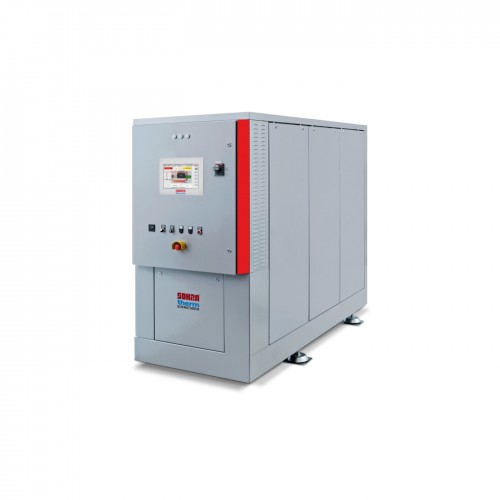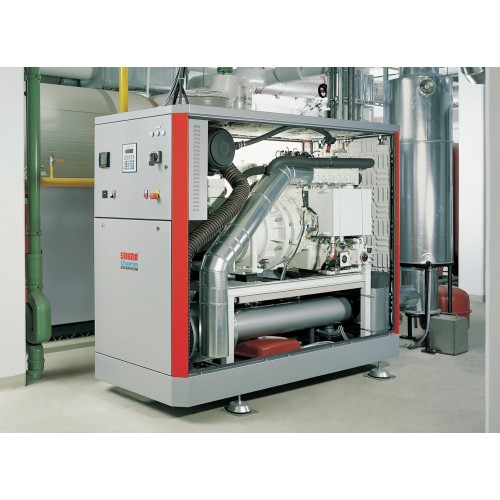Когенераційна установка Sokratherm CHP Unit GG 50 (VR версія)
The CHP Unit GG 50 (VR version) is a modern cogeneration unit that produces heat and power on-site, without transport losses. Due to its high efficiency and ability to quickly turn on and off, this unit is an ideal solution for stabilizing the energy grid and balancing fluctuations in renewable energy production.
The CHP Unit GG 50 (VR version) is a modern cogeneration unit that produces heat and power on-site, without transport losses. Due to its high efficiency and ability to quickly turn on and off, this unit is an ideal solution for stabilizing the energy grid and balancing fluctuations in renewable energy production.
Cogeneration and Trigeneration: What They Are and Their Benefits
Cogeneration is the simultaneous production of heat and electricity from a single energy source, significantly increasing overall fuel efficiency. Trigeneration additionally includes the production of cooling, making this approach even more versatile and efficient.
Benefits of Cogeneration:
- High fuel efficiency.
- Reduced energy costs.
- Minimal energy transport losses.
- Quick response to demand changes.
How Cogeneration and Trigeneration Work
A cogeneration unit operates on an internal combustion engine that drives a generator. The generated electricity is used on-site or fed into the grid, while the heat produced during combustion is used for heating, hot water supply, or industrial needs. In trigeneration, the additional heat is used to produce cooling via absorption chillers.
Advantages of Cogeneration Compared to Traditional Energy Production Methods
- Higher Efficiency: Cogeneration uses up to 90% of the fuel energy, whereas traditional methods use only about 50%.
- Flexibility: The ability to quickly turn on and off allows for better response to demand changes.
- Cost Savings: Reduced energy costs and lower infrastructure expenses.
Environmental Benefits of Cogeneration and Trigeneration
- Reduced CO2 Emissions: Higher fuel efficiency results in lower greenhouse gas emissions.
- Minimized Heat Losses: Using heat that is usually wasted reduces overall fuel consumption.
- Support for Renewable Energy: Stabilizing the grid during fluctuations in renewable energy production.
CHP (Combined Heat and Power Generation): What It Is
CHP, or cogeneration, is a technology that allows simultaneous production of heat and electricity from a single fuel source. The core component of a CHP unit is an internal combustion engine that drives a generator. The electricity can be consumed on-site or fed into the grid, while the heat is used for various needs such as heating and hot water supply.
Unit Sizes
To ensure high annual utilization, cogeneration units are typically sized based on the base heat load of the facility. This approach covers a significant portion of energy consumption, often more than half of the annual heat and power needs. Peak demands are covered by public grids and peak boilers.
Control Systems
The control system for CHP units from Sokratherm ensures complete control and automation of the cogeneration units' operation. It includes real-time monitoring and control functions, maximizing the efficiency and reliability of the units.
Advantages of Sokratherm CHP Units
- Compact Design: Ideal for installation in confined spaces.
- Minimal Installation Costs: Due to ready-to-connect construction with an integrated control panel.
- High Efficiency: Optimal use of fuel energy.
- Environmental Friendliness: Operating the engine in the range with the lowest emissions.
- Low Noise Levels: Excellent sound insulation and vibration decoupling.
- Automation: Fully automatic operation with internet-based remote monitoring and control.
- Reliability: High reliability and low operating and maintenance costs.
Increasing Thermal Efficiency with Condensing Heat Exchangers
At especially low return temperatures (below approximately 50°C), it is often sensible to gain additional heat from the exhaust gases. This can increase the regular thermal power of the unit by up to 15%, raising the total efficiency by several percentage points.
Cooling in Trigeneration
Our cogeneration units can be equipped with a 'Hot Cooling' function, allowing operation at increased flow temperatures up to 95°C. This is necessary for optimal operation of absorption chillers and other processes.
Installation in Containers or Substations
For special application cases, we offer our cogeneration units in weatherproof containers or concrete blocks, allowing them to be placed outside the main buildings.
Steam Production
The heat generated by a cogeneration unit can be used to produce steam, necessary for industrial processes such as in food processing or breweries.
Emergency Power Supply
Our cogeneration units can provide emergency power by operating in island mode, supplying critical systems during a mains failure.
Buffer Heat Storage
Buffer heat storages improve the operation and profitability of cogeneration units by absorbing excess heat and providing it when needed. This enhances the efficiency and economic viability of the units.
Grid Control
The zero feed-in control ensures that the unit does not feed electricity into the public grid, adjusting production to match on-site consumption.
CHP Unit GG 50 (VR version)
Performance Data
Compact cogeneration unit with synchronous alternator to generate three-phase current 400 V, 50 Hz and heating water at a temperature level 90/70 °C. Return riser and speed-controlled pump for constant flow temperature integrated and ready for use. Operates on natural gas, with a three-way catalytic converter for low-emission λ = 1 operation, emission values according to BImSchG § 22. The performance data is valid for an altitude of up to 100 m above sea level and an air temperature of up to 25 °C.
| Operating Mode | Electric Power (gross) | Internal Consumption * | Electric Power (net) | Minimum Electric Power (partial load) | Heating Power (tolerance 8 %) | Gas Input (tolerance 5 %) |
|---|---|---|---|---|---|---|
| Mains Parallel Mode | 50 kW | 1 kW | 49 kW | 25 kW | 84 kW | 145 kW |
| Standby Power System | 57 kVA | 76 kW | 132 kW |
*) without external consumers, preliminary fuse in separate feed (if required): 63 A
Design and Scope of Supply
Engine with Accessories
- Engine Type: MAN E0834 E302
- Combustion Method: Gas Engine
- Cycle: 4-stroke
- Number/Design of Cylinders: 4 in line
- Bore/Stroke: 108/125 mm
- Displacement: 4.58 liters
- Rotation Speed: 1500 rpm
- Average Piston Speed: 6.3 m/s
- Mean Effective Pressure: 9.43 bar
- Compression Ratio: 13:1
- ISO Standard Rating per DIN ISO 3046-1: 54 kW
- Specific Full Load Consumption: 2.69 kWh/kWh
- Full Load Consumption at Hi (Net Calorific) = 10 kWh/Nm³: 14.5 Nm³/h
- Average Synthetic Oil Consumption (estimated): 25 g/h
Engine Description:
- Crankcase: with cylinder block made from one piece of cast iron, closed from below by oil tray.
- Double Cylinder Head: with integrated cooling water and oil ducts.
- Valves: single-axis, steel, carbide.
- Pistons: light-alloy, cooled by oil jet.
- Crankshaft: with five bearings, forged counterweights.
- Intake Manifold: single-flow, water-cooled.
- Oil Pump: with tandem filter.
Gas Supply
Safety gas line according to DVGW-VP 109, vibration-decoupled connection with support angles on the roof of the sound-absorbing case, consisting of ball valve with thermal shutoff, filter, pressure gauge with push-button valve, two solenoid valves, pressure control valve, gas regulation valve, and flexible connecting tube, certified by DVGW. Gas/air mixer with static Venturi insert, electronic speed governor.
Gas Supply and Catalyst
- Lambda Sensor: for automatic regulation of the air/fuel ratio.
- Catalyst: for emission reduction according to German BImSchG standards, built as a three-way catalytic converter for lambda = 1 operation.
Exhaust Silencer
Combined reflection/absorption exhaust silencer made of stainless steel to reduce exhaust noise level, recommended accessory for on-site installation.
Alternator
Synchronous alternator with inner pole, air-cooled, protection class IP 23, build design B3/B5 according to VDE 0530.
- Rated Output: 82 kVA
- Rated Current (nom. power, cos φ 0.8): 90 A
- Efficiency Rate (nom. power): 94.4 %
- Cos φ: 1.0
- Operating Mode: Star
- Ambient Temperature, Max.: 40 °C
- Voltage: 400/231 V
- Frequency / Rotation Speed: 50 Hz / 1500 rpm
Coupling
Engine and alternator rigidly connected by SAE housing and interconnecting flange. Flexible coupling between engine flywheel and alternator shaft.
Base Frame and Pipework
Base frame as a torsion-resistant profile steel construction used to carry the engine/alternator and the following components of the CHP unit: engine cooling circuit pump, heat exchangers, speed-controllable circulation pump, and three-way valve.
Sound-Absorbing Case
Powder-coated steel plate casing with highly effective sound-absorbing lining, ventilation fan with temperature control.
Switch Cabinet
Integrated switch cabinet with power section according to VDE AR-N 4105:2018, on request VDE AR-N 4110:2018 (grid monitoring, synchronization).
Cooling Water Heat Exchanger
The engine cooling water heat is transferred to the heating water via a plate heat exchanger.
- Material: 1.4401
- Thermal Output from Engine Cooling (8 % tolerance): 48 kW
Exhaust Heat Exchanger
The exhaust heat of the engine is transmitted to the heating water through a water-cooled exhaust collector pipe and a tube-type heat exchanger.
- Material: 1.4571 / P235
- Thermal Output (8 % tolerance): 36 kW
- Exhaust Gas Temperature Inlet/Outlet (as new): 620/100 °C
Technical Data and Explanations for Planning and Operation
Fuel
Natural gas of normal composition, free of phosphorus, sulfur, halogens, arsenic and heavy metals, as well as solids and liquids, with constant fuel value and pressure.
- Lower Limit for Lower Calorific Value (Hi): 10 kWh/Nm³
- Methane Number: > 80
Combustion Air and Ventilation
- Combustion Air Requirement: 137 Nm³/h
- Inlet Air Temperature Min./Max.: 10/30 °C
Exhaust Gas
- Exhaust Gas Flow Rate at 100 °C: 220 Nm³/h
Sound Levels
- Engine Sound Level (with/without sound-absorbing case): 62/81 dB(A)
Heat Production
- Return Temperature to Unit (Min./Max.): 40/70 °C
Filling Quantities and Quality Demands
- Oil Tray Volume: 13 liters
- Oil Storage Tank Volume: 59 liters
- Engine and Heat Exchanger Coolant Volume: 19 liters
- Heating Water Treatment: according to VDI guideline 2035 (group 4).
Dimensions, Connections and Weight
- Length (Basic Measurements): 2200 mm
- Width: 900 mm
- Height: 1830 mm
- Operating Weight: 1950 kg
- Dry Weight: 1840 kg



-default-500x500.jpg)














